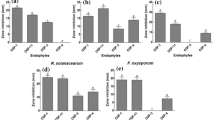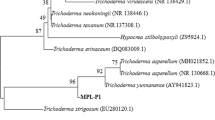Abstract
Ocimum, an important commercial aromatic crop, is well known for the industrially acclaimed essential oil. In the present study, a comparative analysis was performed between Trichoderma harzianum (ThU) and its secondary metabolites on plant growth, essential oil and phytochemical parameters in O. basilicum and O. sanctum. A significant enhancement in biomass and essential oil content (2.37 and 2.16 fold, respectively) was observed in the live culture of ThU (TH_CC) treatment of O. basilicum, whereas its metabolites (TH_CF) enhanced biomass (1.25 folds) and essential oil (2.17 folds) in O. sanctum as compared to their respective controls. The present study first time highlights species dependent response in plants by the application of TH_CC and TH_CF to enhance plant growth, antioxidants and oil content of Ocimum. The present results thus provide a better understanding of the host specific response to ThU and its metabolites which can be used to develop effective biofertilizers for crop improvement.



Similar content being viewed by others
References
Gupta R, Pandey R (2015) Microbial interference ameliorates essential oil yield and diminishes root-knot infestation in sweet basil under field conditions. Biocontrol Sci Technol 25:1165–1179
Sajjadi SE (2006) Analysis of the essential oils of two cultivated basil (Ocimum basilicum L.) from Iran. DARU J Pharm Sci 14:128–130
Hussain AI, Anwar F, Sherazi STH, Przybylski R (2008) Chemical composition, antioxidant and antimicrobial activities of basil (Ocimum basilicum) essential oils depend on seasonal variations. Food Chem 108:986–995
Saharan BS, Verma S (2015) Evaluation of rhizospheric bacteria from Ocimum sp. as potential PGPR. J Microb Biochem Technol 7:088–095
Gupta R, Tiwari S, Saikia SK, Shukla V, Singh R, Singh SP, Ajay Kumar PV, Pandey R (2015) Exploitation of microbes for enhancing bacoside content and reduction of Meloidogyne incognita infestation in Bacopa monnieri L. Protoplasma 252:53–61
Vinale F, Sivasithamparam K, Ghisalberti EL, Ruocco M, Wood S, Lorito M (2012) Trichoderma secondary metabolites that affect plant metabolism. Nat Prod Commun 7:1545–1550
Compant S, Clément C, Sessitsch A (2010) Plant growth-promoting bacteria in the rhizo-and endosphere of plants: their role, colonization, mechanisms involved and prospects for utilization. Soil Biol Biochem 42:669–678
Arnon DI (1949) Copper enzymes in isolated chloroplasts, polyphenoloxidase in Beta vulgaris. Plant Physiol 24:1–15
Lichtenthaler HK, Wellburn AR (1983) Determinations of total carotenoids and chlorophylls a and b of leaf extracts in different solvents. Biochem Soc Trans 11:591–592
Yemm EW, Willis AJ (1954) The estimation of carbohydrates in plant extracts by anthrone. Biochem J 57:508–514
Singleton VL, Rossi JA (1965) Colorimetry of total phenolics with phosphomolybdic-phosphotungstic acid reagents. Am J Enol Vitic 16:144–158
Zhishen J, Mengcheng T, Jianming W (1999) The determination of flavonoid contents in mulberry and their scavenging effects on superoxide radicals. Food Chem 64:555–559
Brand-Williams W, Cuvelier ME, Berset CLWT (1995) Use of a free radical method to evaluate antioxidant activity. LWT Food Sci Technol 28:25–30
Zheng W, Wang SY (2001) Antioxidant activity and phenolic compounds in selected herbs. J Agric Food Chem 49:5165–5170
Gupta R, Saikia SK, Pandey R (2015) Bioconsortia augments antioxidant and yield in Matricaria recutita L. against Meloidogyne incognita (Kofoid and White) Chitwood infestation. Proc Nat Acad Sci Ind Sec B Biol. doi:10.1007/s40011-015-0621-y
Pandey R, Mishra AK, Tiwari S, Singh HN, Kalra A (2011) Enhanced tolerance of Mentha arvensis against Meloidogyne incognita (Kofoid and White) Chitwood through mutualistic endophytes and PGPRs. J Plant Interact 6:247–253
Nigro M, Vinale F, Ruocco M, Woo SL, Lanzuise S, Marra R, Eid A, Lorito M (2012) Role of Trichoderma secondary metabolites in plant interactions: the metabolic changes in Arabidopsis thaliana. J Plant Pathol 94:71
Yadava S, Sarangi PK, Das M (2014) Ecotechnology of compost from biodegradables inoculated by Trichoderma and its effects on growth of medicinal plant Ocimum gratissimum L. Ann Plant Sci 3:610–613
Vafadar F, Amooaghaie R, Otroshy M (2014) Effects of plant-growth-promoting rhizobacteria and arbuscular mycorrhizal fungus on plant growth, stevioside, NPK, and chlorophyll content of Stevia rebaudiana. J Plant Interact 9:128–136
Gupta R, Singh A, Pandey R (2016) Microbes based technology ameliorates glandular trichomes, secondary metabolites and antioxidant in Pelargonium graveolens L’Her. J Sci Food Agric. doi:10.1002/jsfa.7617
Keswani C, Mishra S, Sarma BK, Singh SP, Singh HB (2014) Unraveling the efficient applications of secondary metabolites of various Trichoderma spp. Appl Microbiol Biotechnol 98:533–544
Mukherjee PK, Horwitz BA, Kenerley CM (2012) Secondary metabolism in Trichoderma—a genomic perspective. Microbiol 158:35–45
Singh A, Jain A, Sarma BK, Upadhyay RS, Singh HB (2014) Beneficial compatible microbes enhance antioxidants in chickpea edible parts through synergistic interactions. LWT Food Sci Technol 56:390–397
Acknowledgments
This research was funded by CSIR-Twelfth Five Year Plan Project (BSC0203). The authors are thankful to the Director, CSIR-Central Institute of Medicinal and Aromatic Plants Lucknow, India for providing necessary facilities. Help extended by Dr. C. S Chanotiya and Ms. Anju Yadav in GC analysis is greatly appreciated.
Author information
Authors and Affiliations
Corresponding author
Ethics declarations
Conflict of interest
The authors declare that there exists no potential conflict of interest among them.
Electronic supplementary material
Below is the link to the electronic supplementary material.
Rights and permissions
About this article
Cite this article
Gupta, R., Singh, A., Kanaujia, R. et al. Trichoderma harzianum ThU and Its Metabolites Underscore Alteration in Essential Oils of Ocimum basilicum and Ocimum sanctum . Proc. Natl. Acad. Sci., India, Sect. B Biol. Sci. 88, 219–227 (2018). https://doi.org/10.1007/s40011-016-0753-8
Received:
Revised:
Accepted:
Published:
Issue Date:
DOI: https://doi.org/10.1007/s40011-016-0753-8




